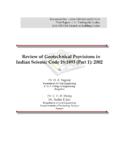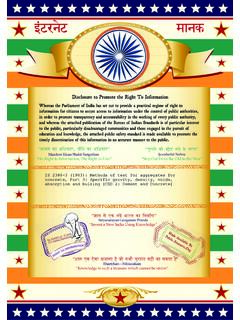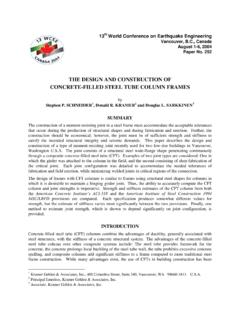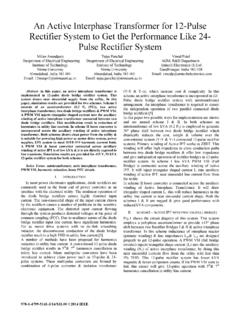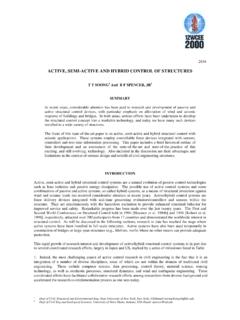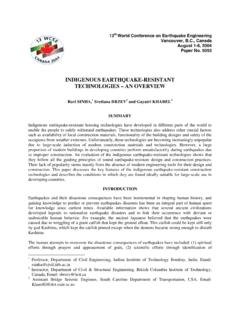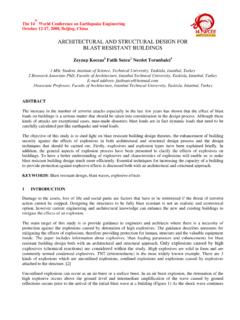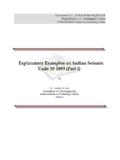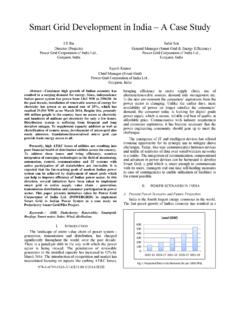Transcription of Limitations of available Indian Hot-Rolled I-Sections for ...
1 Limitations of available Indian Hot-Rolled I-Sections for use in Seismic Steel MRFs Rupen Goswami 1, Jaswant N. Arlekar 2 and Murty 3 Abstract Steel hot rolled I-Sections have been in use in construction since long in India. With advancement of technology to build moment resisting frames (MRFs) to resist seismic actions, a review of the existing available sections is required to assess their applicability. This paper reiterates the important aspects of the seismic design philosophy and investigates the available sections in light of the same. The sectional properties (strength and stability) are studied in light of the different code requirements for desired performance under strong seismic conditions.
2 Indian Hot-Rolled I-Sections (tapered and parallel flanges) are found inadequate for use in tall structures in high seismic regions. 1. Introduction Satisfactory performance of steel structures in high seismic regions depends on numerous factors. Three significant factors in design are stability, strength and ductility of individual members. Apart from these, connections play an important role in the overall performance of the structure; inadequate connections can result in failure of the structure even if the structural members are adequately designed. A proper design considering these, together with a satisfactory collapse mechanism under strong seismic shaking results in good overall performance of the structure.
3 In this paper, the international state-of-the-art seismic design provisions for steel sections are reviewed. The limited range of Hot-Rolled steel I-Sections available in India for steel construction are evaluated to identify the suitability of their use in high seismic environment. 2. Strength Criteria and Capacity Design Philosophy In the past few decades, the evolution of the Capacity Design concept is one of the most important developments in the field of earthquake-resistant design of structures [ , Paulay and Priestly, 1992]. Through this concept, structures can be designed to behave in a pre-determined manner during strong earthquake shaking. This includes, most importantly, preventing brittle types of failure and forcing ductile action in the structural components.
4 Also, while ensuring that a pre-determined desired mechanism occurs (for instance, beam sway mechanism is preferred over storey mechanism in 1 Scholar, Department of Civil Engineering, IIT Kanpur, Kanpur 208016; 2 Formerly Scholar, Department of Civil Engineering, IIT Kanpur, Kanpur 208016; 3 Professor, Department of Civil Engineering, IIT Kanpur, Kanpur 208016; 2 multistorey building MRFs), the most common design practice evolved, namely the strong-column weak-beam approach of proportioning frame members is used. Further, following the large number of connection failures in steel MRFs during the 1994 Northridge earthquake (USA) and 1995 Kobe earthquake (Japan), the seismic design of beam-to-column connections now requires that these connections be designed as per the capacity design concept.
5 In summary, the capacity design concept enlists a strength hierarchy of the components of a building: (a) the beam-to-column connections joint are to be stronger than the beam, (b) the columns are to be stronger than the beams, and (c) the column base connections are to be stronger than the column [Penelis and Kappos, 1997]. In the above consideration of the earthquake-resistant design philosophy, estimation of the maximum strength that is achievable in a member (beam/column) under strong earthquake shaking is important. This strength, called the overstrength capacity, is more than the nominal strength of the members obtained using the code-specified design procedures.
6 Overstrength occurs due to redundancy in the structural system, the partial safety factors for materials, and differences in the actual and idealized stress-strain curves of materials. Two factors related to the last aspect causing material overstrength are discussed in the following. Yield Strength of Material The existing code procedures for the design of steel members are based on the minimum specified characteristic yield strength fy. However, coupon tests have shown that the actual yield strength of material are often higher than the minimum specified yield strength [Engelhardt and Sabol, 1998; Malley and Frank, 2000]. This causes an increase in actual member strength over that estimated using code-prescribed procedures.
7 AISC [AISC, 2002] indicates that the ratio of the expected yield strength to the minimum specified characteristic yield strength, herein named yR, varies between to depending on the grade of steel. In India, such data for the available Indian sections are not readily available in public literature, and also, the current code provisions do not account for this. Such statistical data from the Indian Hot-Rolled sections obtained through coupon test need to be incorporated in seismic design procedures. 3 Strain Hardening of Steel The Indian steel code [IS:800, 1984] assumes an idealized elastic perfectly-plastic constitutive law for structural steel with characteristic yield strength as fy.
8 In reality, structural steel has a distinct constitutive relation (Figure 1) with an initial elastic zone (OA), a yield plateau (AB), a strain-hardening zone (BC), and a strain-softening zone (CD) before it fractures. The member nominal flexural strength, , plastic moment capacity pMfor bending about the major axis, is computed based on the idealized rectangular stress block with a maximum stress of fy. Such a stress block is not practically achievable, because to develop a stress of yf at the fibers at and near the neutral axis, the strains required at the extreme fibers of the section are infinitely large. Secondly, the rectangular stress block can never be achieved without strain-hardening of the extreme fibers of the beam section.
9 Thus, the representation of pM using rectangular stress blocks deviates from the actual behavior. Figure 1: Typical schematic of constitutive curve of structural steel: Four distinct zones are evident - a linear elastic zone OA, a yield plateau AB, a strain-hardening zone BC and a strain-softening zone CD. The beam bending moment equal to the plastic moment value pM can be realized in a section only when a part of it undergoes strain-hardening while some of it still remains elastic (Figure 2). Thus, the beam design based on pM indirectly accounts for only a marginal amount of strain-hardening. However, although the maximum capacity of the beam corresponding to the ultimate stress uf in the extreme fiber may never be achieved (as the associated curvature ductility demands of around 100 and deformations required to accommodate such large curvatures are impractical); recent experimental studies [Englehardt and Sabol, 1998] show that beam capacities larger than pM are definitely achievable with inelastic deformations corresponding to the Strain r u sh y u Stress O A B C D y 4 drift demands expected by some code guidelines [UBC, 1997; FEMA, 1995].
10 Thus, it is the strain-hardening of steel that causes an increase in the member capacity under strong seismic shaking over the code-prescribed nominal capacity pM. Curvature ductility imposed at a section can be estimated from the amount of plastic rotation p required to be developed at the end of the member, using [ , Arlekar and Murty, 2000b] dMEIpp 2=, (1) where d and EI are the depth and flexural rigidity of the member. The AISC code recommended plastic rotation demand p varies between and radians. Since Indian steel code specifies no such demand, experiments need to be conducted on MRFs made using Indian Standards sections to determine desirable plastic rotations and develop associated design guidelines.
